
|
Present
Past
Subjects
Projects
Misc

|
IMMORTALITY SUITE
Notes (in progress!) to the exhibition 'Immortality Suite' in the Groninger Museum (Groningen, the Netherlands, 22nd of December 2001 to the 17th of April 2002).
Introduction
Introductory text by Sue-an van der Zijpp for the doors of the Coop Himmelblau Pavilion.
Nuclear Garden II
(2001. Steel, resin, uranium ore, water. 160 x 600 x 250 cm.)
"Nuclear Garden, an extremely formal (you might say twice formal) rock garden containing a sub-critical nuclear reactor..."
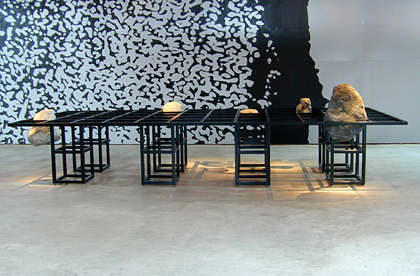
Nuclear Garden II, Groninger Museum, 2001.
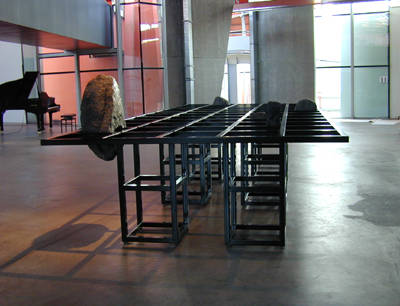
Nuclear Garden II, Groninger Museum, 2001.
Background -
Nuclear Garden has a somewhat checkered history both in terms of its conception and realisation -- the 'content' of this work being twice banned (both times not out of safety concerns but out concern for bad press) before its present realisation (though again this time concessions have been made and it is shown in less than ideal form).
Originally conceived in 1997 for the exhibition project St(*)boretum (Wageningen, 1998), Nuclear Garden emerged out of my concerns with radical life extension and longevity... in a way you could say out of an extremely different context... as the original idea for St(*)boretum was to design and build a longevity module, a sort of futuristic Noah's ark (or wunderkamer) containing various long-living life forms (such as the extremely strange Nambian desert plant Welwitschia mirabilis).
Sometime during this period (I worked about a year all told on the longevity module idea) I had a dream about a Zen garden, like Ryoan-ji in Kyoto, which contained, in addition to its stones, a nuclear reactor. Upon awaking I was convinced that such a garden would be built one day. Towards the end of 1997 (I remember the moment, I was on a bus) the dream of the garden suddenly merged with the concept I'd been developing. A few days later I wrote a note to the board of the exhibition (The Master Containment) defending my change of plans. A radioactive source was much more interesting than longevitous genes.
Less than a month before the exhibition was to open in Wageningen the work was banned for the first time (Alamut entry: 15.04.98). Despite our strongest protest and our appeal to 'scientific' rationality (the work was actually banned by a scientific organisation see: Art, Science and the 'U' Word) the first version of Nuclear Garden had to be exhibited in unfinished form. The whole affair took me by complete suprise and I was very disappointed. Even more so when the work was suddenly banned for a second time (this time by a cultural organisation) a couple months later.
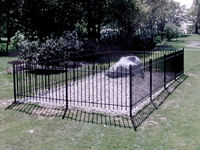
Nuclear Garden, Wageningen, 1998.
See further:
Criticality (in Physics and Art) I
Criticality (in Physics and Art) II
Criticality (in Physics and Art) III
Criticality (in Physics and Art) IV
A Thousand Deaths: Sortie 2
"... One Thousand Deaths: Sortie 2, a film about my own staged near-death experience..."
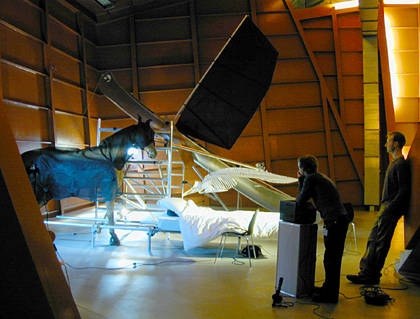
Tuesday, 11 December 2001. The film set in the museum about an hour before we started. (Paul Sixta and Roger Muskee consider the lighting.)
Note: I'll be adding links to two pages of stills here, one for Sortie 1 (Alamut entry: 09.12.00) and one for Sortie 2.
Afterlife or Repeat After Me
Reproducing piano, porpoise skeleton, carbon fiber, plastic. Variable dimensions.
"... and 'Afterlife, or Repeat After Me', a kinetic piece which explores the concept of 'self-liberating' objects. Not only does the porpoise float through the space, the piano too has become 'auto-mobile', in that it perfectly reproduces three compositions by Frankfurter Ballet composer Thom Willems."
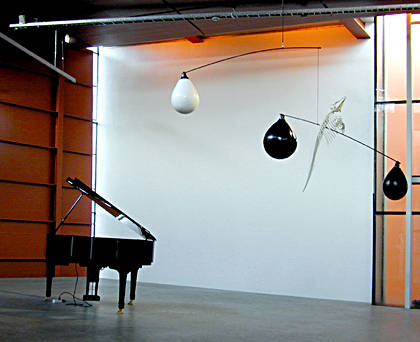
Afterlife or Repeat After Me, 2001.
Installation Views
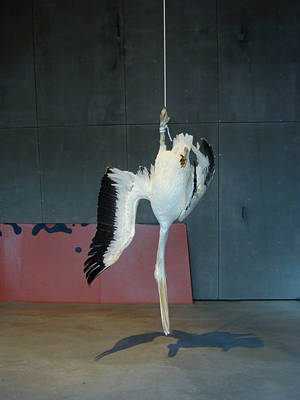
Pelican.
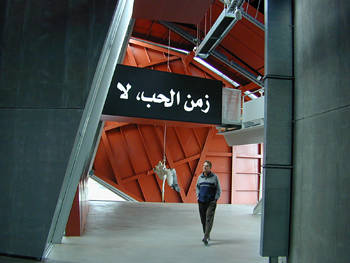
Overview right-hand room Himmelblau pavilion with hanging pelican in the background.
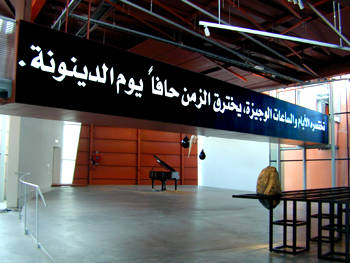
Overview center room Coop Himmelblau pavilion
Interviews
INS Interview: March 2001 Paul Perry interviewed by Tom McCarthy, General Secretary of the International Necronautical Society. ("An excellent primer to Perry's work and thought...") Groninger Museum Interview: November 2001 Paul Perry interviewed by Sue-An van der Zijpp, curator of the Groninger Museum.
Press
Groninger Museum Article: December 2001 - Article (in Dutch) for the Groninger Museum magazine, December 2001. Based on the November 2001 interview and a number of telephone conversations with Sue-an van der Zijpp, curator of the Groninger Museum.
ALAMUT.COM is artist owned and operated.
Mail: current address.

|

|








